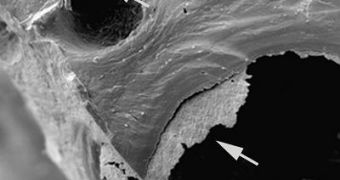In 2005, a team of paleontologists rushed to claim that they had discovered soft tissue in a dinosaur fossil belonging to a Tyrannosaurus rex that lived more than 65 million years ago. Now, a new study contests the findings of the previous one by revealing that the so-called soft tissue sample is in fact only a biofilm or slime at best.
"I believed that preserved soft tissues had been found, but I had to change my opinion. You have to go where the science leads, and the science leads me to believe that this is bacterial biofilm," said Thomas Kaye, an associate researcher at the Burke Museum of Natural History and Culture at the University of Washington.
The original study that appeared nearly three years ago said that the research team had discovered blood vessels and even whole cells inside a dinosaur bone fragment, and had been successful in extracting them by dissolving the fossil into acid. However, when Kaye went to look for his own sample, he discovered that the soft material hadn't come from the dinosaur itself, but it was most likely the product of bacterial films growing inside the bone after the T. rex died. "We cracked open a lot of bones and spent hundreds of hours on an electron microscope examining them," Kaye added.
Biofilms form thin layers of soft tissue through a phenomenon rather similar to that when you leave a bucket filled with rainwater for several weeks. The inner walls of the bucket will get a slimy texture. "If you could dissolve the bucket away, you'd find soft, squishy material in the shape of the bucket, and that's the slime. The same is true for dinosaur bones. If you dissolve away the bone, what's left is biofilm in the shape of vascular canals," Kaye said.
Nonetheless, the original author of the study, Mary Schweitzer of the North Carolina State University, still claims that the found material is dinosaur collagen, indicating that chicken collagen bears similar resemblance to the soft tissue discovered in the T. rex fossils, exactly as predicted, since chicken evolved from a species of dinosaurs.
"Kaye did not offer any explanation for how 'biofilm' proteins from dinosaur could cluster with chicken, while 'biofilm' from mammoth and mastodon cluster with elephant," said Schweitzer.

 14 DAY TRIAL //
14 DAY TRIAL //